Advanced issues in accounting - Assignment
VerifiedAdded on 2021/06/14
|8
|1970
|35
AI Summary
Contribute Materials
Your contribution can guide someone’s learning journey. Share your
documents today.
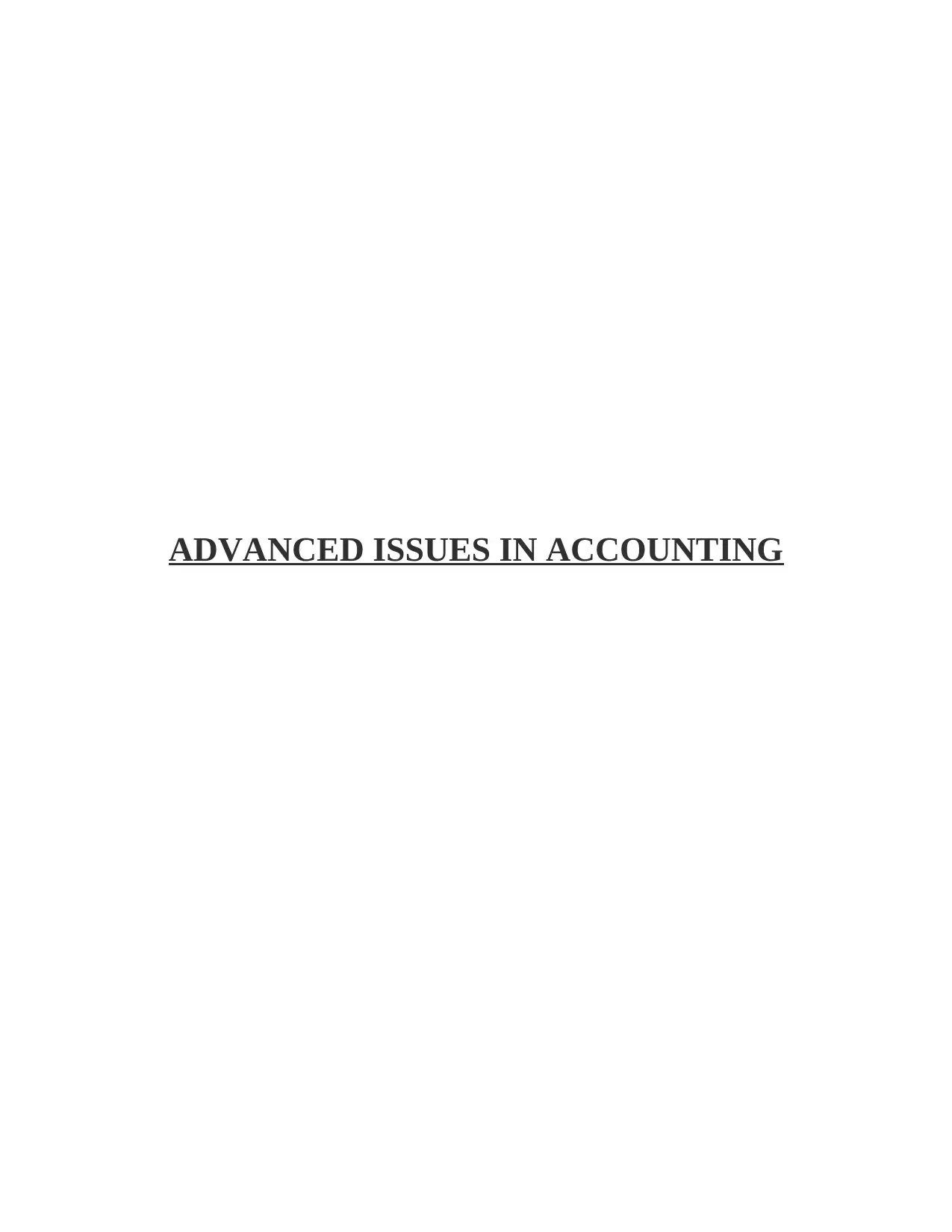
ADVANCED ISSUES IN ACCOUNTING
Secure Best Marks with AI Grader
Need help grading? Try our AI Grader for instant feedback on your assignments.

INTRODUCTION
BP was known as one of the most organized leaders in sustainability reporting before the
disastrous deepwater horizon drilling rig explosion took place. In April 2010 the explosion
followed with the fire lead to the sinking of the Deepwater Horizon that resulted in the death of
the 11 workers with 17 injured. The same uncontrolled release that already caused the explosion
also resulted in the destructive offshore oil spill in the Gulf Of Mexico. Probably, this accident is
considered as the largest environmental disaster in U.S history (Case, 2012).
The oil spill disaster raises genuine CSR issues. BP, through its reports highly committed to
public about developing energy , community development and strong management systems for
environment and social protection. However, after happening of such an event, the gaps could be
visualized between what’s stated as a perception and what’s the reality for the CSR Industry
(Donanldson, 2012).
CSR reports are important to providea transparentreport of a company’s practices and how the
society is at stake.The question that arises is how the deepwater horizon explosion became a
matter of non compliance with social responsibilities (Freeman, 2011). Basically, such CSR
reports are responsible for addressing the issues that may have an effect on the society as
transparency is all that is desired . In the given case, the concern for safety was visible in the
CSR reports in the form of expert’s judgments and such other comments regarding
improvements by the assurance provider. However, the terms “sustainable continuous
improvement” overlooked the stress on the risks they were associated with. Such a crisis
demands a serious need for development of CSR reports with proper accountingapproaches and
related standards for attestation of such reports (Edwards, 2014).
There are several approaches for accounting of CSR that can be adopted by the case organization
for providing reliable, consistent and tansparent information to its stakeholders .
BP was known as one of the most organized leaders in sustainability reporting before the
disastrous deepwater horizon drilling rig explosion took place. In April 2010 the explosion
followed with the fire lead to the sinking of the Deepwater Horizon that resulted in the death of
the 11 workers with 17 injured. The same uncontrolled release that already caused the explosion
also resulted in the destructive offshore oil spill in the Gulf Of Mexico. Probably, this accident is
considered as the largest environmental disaster in U.S history (Case, 2012).
The oil spill disaster raises genuine CSR issues. BP, through its reports highly committed to
public about developing energy , community development and strong management systems for
environment and social protection. However, after happening of such an event, the gaps could be
visualized between what’s stated as a perception and what’s the reality for the CSR Industry
(Donanldson, 2012).
CSR reports are important to providea transparentreport of a company’s practices and how the
society is at stake.The question that arises is how the deepwater horizon explosion became a
matter of non compliance with social responsibilities (Freeman, 2011). Basically, such CSR
reports are responsible for addressing the issues that may have an effect on the society as
transparency is all that is desired . In the given case, the concern for safety was visible in the
CSR reports in the form of expert’s judgments and such other comments regarding
improvements by the assurance provider. However, the terms “sustainable continuous
improvement” overlooked the stress on the risks they were associated with. Such a crisis
demands a serious need for development of CSR reports with proper accountingapproaches and
related standards for attestation of such reports (Edwards, 2014).
There are several approaches for accounting of CSR that can be adopted by the case organization
for providing reliable, consistent and tansparent information to its stakeholders .
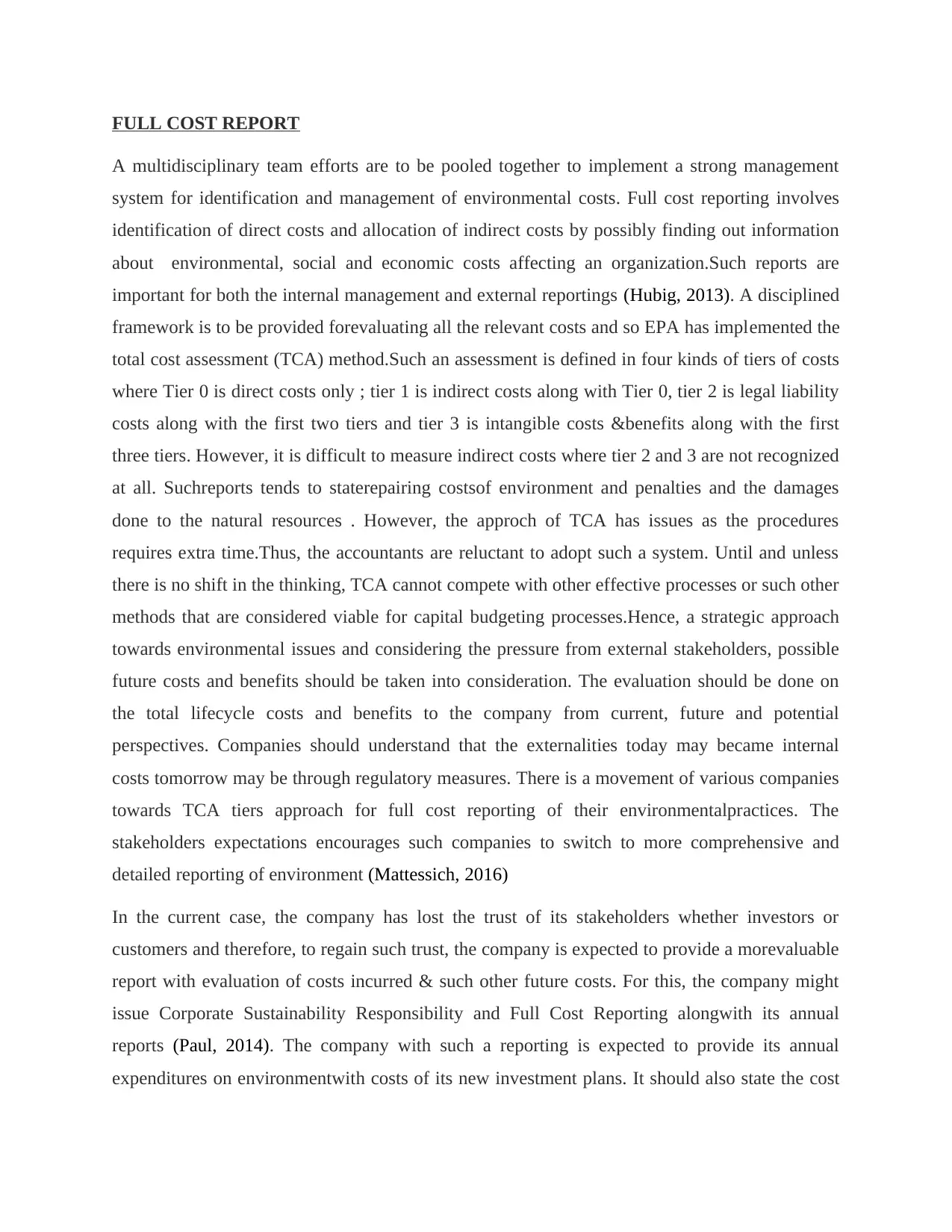
FULL COST REPORT
A multidisciplinary team efforts are to be pooled together to implement a strong management
system for identification and management of environmental costs. Full cost reporting involves
identification of direct costs and allocation of indirect costs by possibly finding out information
about environmental, social and economic costs affecting an organization.Such reports are
important for both the internal management and external reportings (Hubig, 2013). A disciplined
framework is to be provided forevaluating all the relevant costs and so EPA has implemented the
total cost assessment (TCA) method.Such an assessment is defined in four kinds of tiers of costs
where Tier 0 is direct costs only ; tier 1 is indirect costs along with Tier 0, tier 2 is legal liability
costs along with the first two tiers and tier 3 is intangible costs &benefits along with the first
three tiers. However, it is difficult to measure indirect costs where tier 2 and 3 are not recognized
at all. Suchreports tends to staterepairing costsof environment and penalties and the damages
done to the natural resources . However, the approch of TCA has issues as the procedures
requires extra time.Thus, the accountants are reluctant to adopt such a system. Until and unless
there is no shift in the thinking, TCA cannot compete with other effective processes or such other
methods that are considered viable for capital budgeting processes.Hence, a strategic approach
towards environmental issues and considering the pressure from external stakeholders, possible
future costs and benefits should be taken into consideration. The evaluation should be done on
the total lifecycle costs and benefits to the company from current, future and potential
perspectives. Companies should understand that the externalities today may became internal
costs tomorrow may be through regulatory measures. There is a movement of various companies
towards TCA tiers approach for full cost reporting of their environmentalpractices. The
stakeholders expectations encourages such companies to switch to more comprehensive and
detailed reporting of environment (Mattessich, 2016)
In the current case, the company has lost the trust of its stakeholders whether investors or
customers and therefore, to regain such trust, the company is expected to provide a morevaluable
report with evaluation of costs incurred & such other future costs. For this, the company might
issue Corporate Sustainability Responsibility and Full Cost Reporting alongwith its annual
reports (Paul, 2014). The company with such a reporting is expected to provide its annual
expenditures on environmentwith costs of its new investment plans. It should also state the cost
A multidisciplinary team efforts are to be pooled together to implement a strong management
system for identification and management of environmental costs. Full cost reporting involves
identification of direct costs and allocation of indirect costs by possibly finding out information
about environmental, social and economic costs affecting an organization.Such reports are
important for both the internal management and external reportings (Hubig, 2013). A disciplined
framework is to be provided forevaluating all the relevant costs and so EPA has implemented the
total cost assessment (TCA) method.Such an assessment is defined in four kinds of tiers of costs
where Tier 0 is direct costs only ; tier 1 is indirect costs along with Tier 0, tier 2 is legal liability
costs along with the first two tiers and tier 3 is intangible costs &benefits along with the first
three tiers. However, it is difficult to measure indirect costs where tier 2 and 3 are not recognized
at all. Suchreports tends to staterepairing costsof environment and penalties and the damages
done to the natural resources . However, the approch of TCA has issues as the procedures
requires extra time.Thus, the accountants are reluctant to adopt such a system. Until and unless
there is no shift in the thinking, TCA cannot compete with other effective processes or such other
methods that are considered viable for capital budgeting processes.Hence, a strategic approach
towards environmental issues and considering the pressure from external stakeholders, possible
future costs and benefits should be taken into consideration. The evaluation should be done on
the total lifecycle costs and benefits to the company from current, future and potential
perspectives. Companies should understand that the externalities today may became internal
costs tomorrow may be through regulatory measures. There is a movement of various companies
towards TCA tiers approach for full cost reporting of their environmentalpractices. The
stakeholders expectations encourages such companies to switch to more comprehensive and
detailed reporting of environment (Mattessich, 2016)
In the current case, the company has lost the trust of its stakeholders whether investors or
customers and therefore, to regain such trust, the company is expected to provide a morevaluable
report with evaluation of costs incurred & such other future costs. For this, the company might
issue Corporate Sustainability Responsibility and Full Cost Reporting alongwith its annual
reports (Paul, 2014). The company with such a reporting is expected to provide its annual
expenditures on environmentwith costs of its new investment plans. It should also state the cost
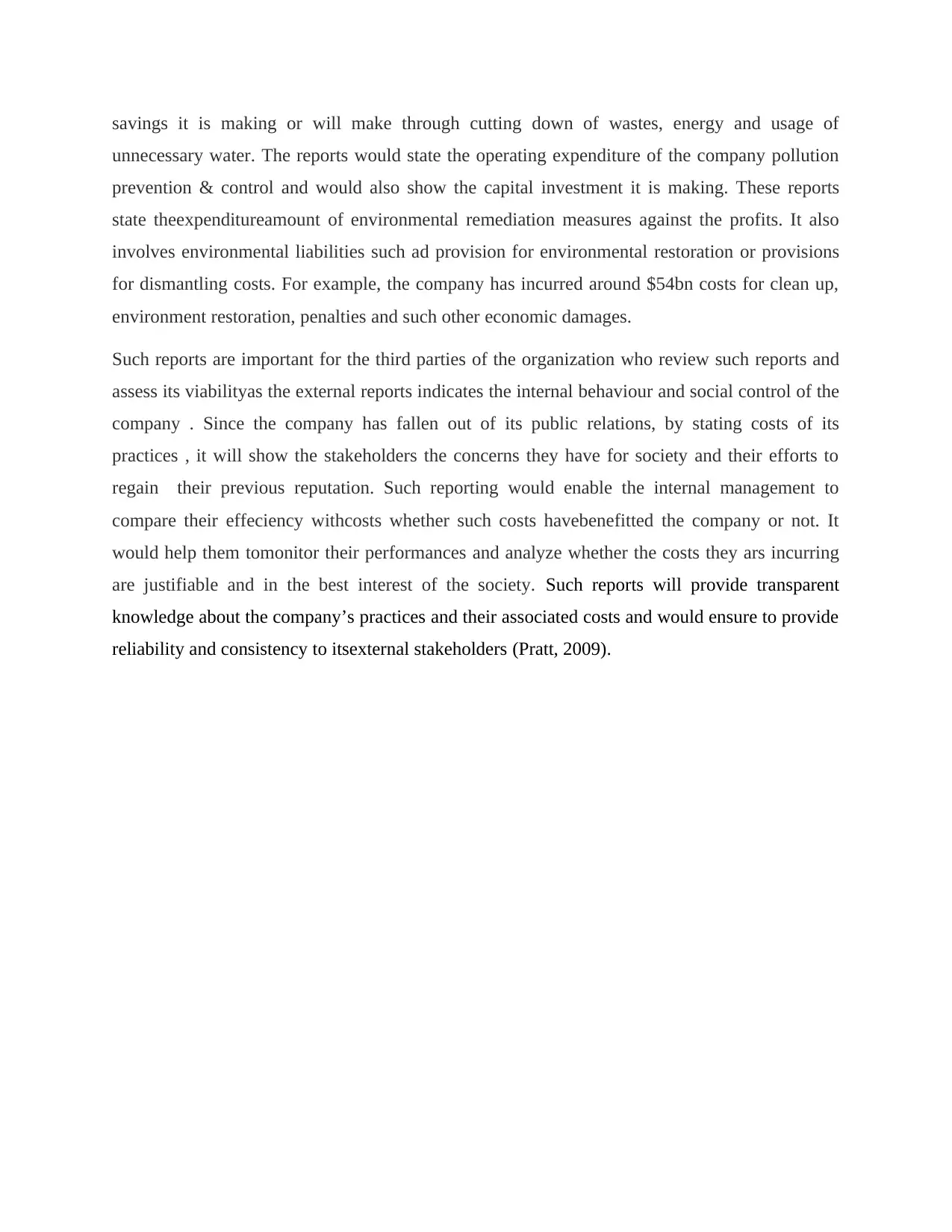
savings it is making or will make through cutting down of wastes, energy and usage of
unnecessary water. The reports would state the operating expenditure of the company pollution
prevention & control and would also show the capital investment it is making. These reports
state theexpenditureamount of environmental remediation measures against the profits. It also
involves environmental liabilities such ad provision for environmental restoration or provisions
for dismantling costs. For example, the company has incurred around $54bn costs for clean up,
environment restoration, penalties and such other economic damages.
Such reports are important for the third parties of the organization who review such reports and
assess its viabilityas the external reports indicates the internal behaviour and social control of the
company . Since the company has fallen out of its public relations, by stating costs of its
practices , it will show the stakeholders the concerns they have for society and their efforts to
regain their previous reputation. Such reporting would enable the internal management to
compare their effeciency withcosts whether such costs havebenefitted the company or not. It
would help them tomonitor their performances and analyze whether the costs they ars incurring
are justifiable and in the best interest of the society. Such reports will provide transparent
knowledge about the company’s practices and their associated costs and would ensure to provide
reliability and consistency to itsexternal stakeholders (Pratt, 2009).
unnecessary water. The reports would state the operating expenditure of the company pollution
prevention & control and would also show the capital investment it is making. These reports
state theexpenditureamount of environmental remediation measures against the profits. It also
involves environmental liabilities such ad provision for environmental restoration or provisions
for dismantling costs. For example, the company has incurred around $54bn costs for clean up,
environment restoration, penalties and such other economic damages.
Such reports are important for the third parties of the organization who review such reports and
assess its viabilityas the external reports indicates the internal behaviour and social control of the
company . Since the company has fallen out of its public relations, by stating costs of its
practices , it will show the stakeholders the concerns they have for society and their efforts to
regain their previous reputation. Such reporting would enable the internal management to
compare their effeciency withcosts whether such costs havebenefitted the company or not. It
would help them tomonitor their performances and analyze whether the costs they ars incurring
are justifiable and in the best interest of the society. Such reports will provide transparent
knowledge about the company’s practices and their associated costs and would ensure to provide
reliability and consistency to itsexternal stakeholders (Pratt, 2009).
Secure Best Marks with AI Grader
Need help grading? Try our AI Grader for instant feedback on your assignments.
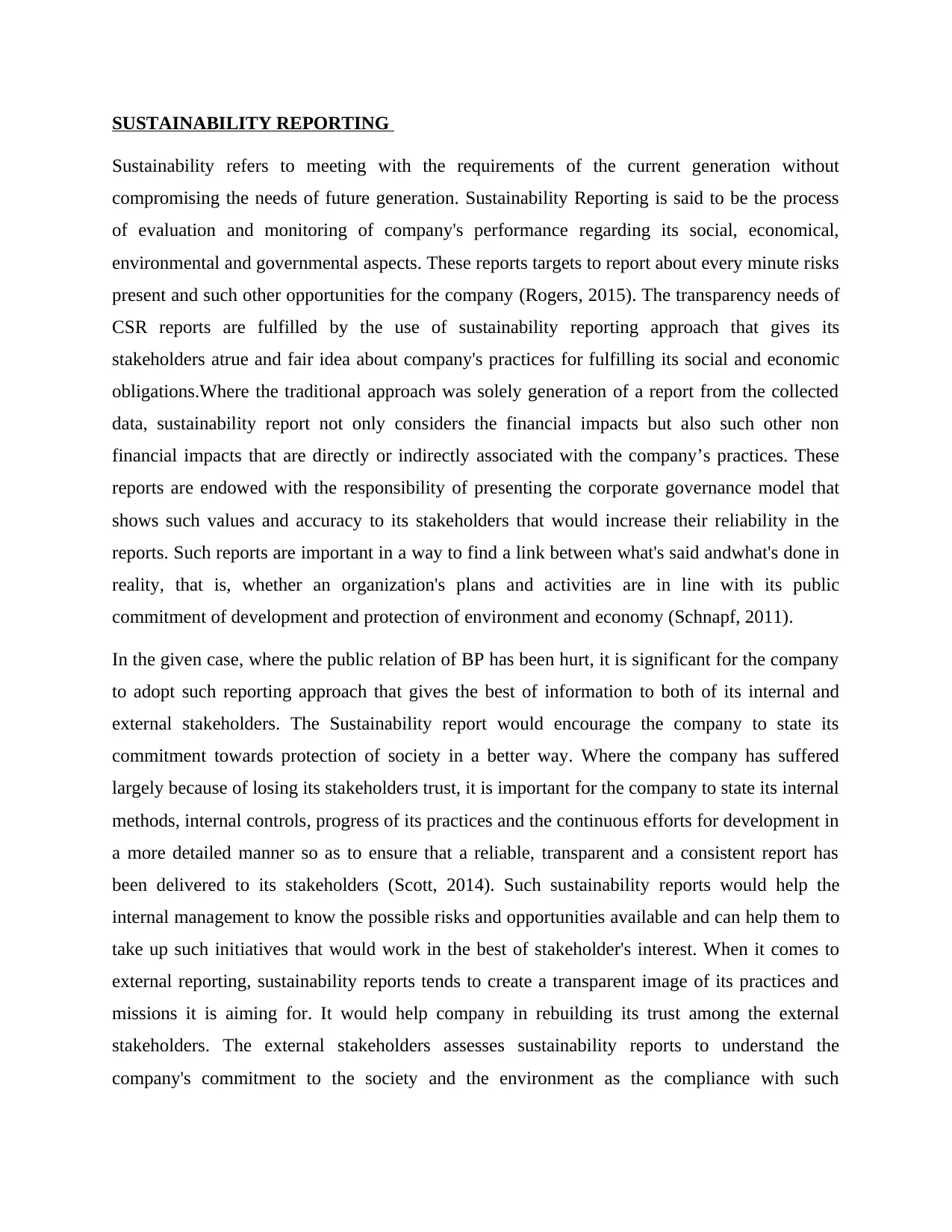
SUSTAINABILITY REPORTING
Sustainability refers to meeting with the requirements of the current generation without
compromising the needs of future generation. Sustainability Reporting is said to be the process
of evaluation and monitoring of company's performance regarding its social, economical,
environmental and governmental aspects. These reports targets to report about every minute risks
present and such other opportunities for the company (Rogers, 2015). The transparency needs of
CSR reports are fulfilled by the use of sustainability reporting approach that gives its
stakeholders atrue and fair idea about company's practices for fulfilling its social and economic
obligations.Where the traditional approach was solely generation of a report from the collected
data, sustainability report not only considers the financial impacts but also such other non
financial impacts that are directly or indirectly associated with the company’s practices. These
reports are endowed with the responsibility of presenting the corporate governance model that
shows such values and accuracy to its stakeholders that would increase their reliability in the
reports. Such reports are important in a way to find a link between what's said andwhat's done in
reality, that is, whether an organization's plans and activities are in line with its public
commitment of development and protection of environment and economy (Schnapf, 2011).
In the given case, where the public relation of BP has been hurt, it is significant for the company
to adopt such reporting approach that gives the best of information to both of its internal and
external stakeholders. The Sustainability report would encourage the company to state its
commitment towards protection of society in a better way. Where the company has suffered
largely because of losing its stakeholders trust, it is important for the company to state its internal
methods, internal controls, progress of its practices and the continuous efforts for development in
a more detailed manner so as to ensure that a reliable, transparent and a consistent report has
been delivered to its stakeholders (Scott, 2014). Such sustainability reports would help the
internal management to know the possible risks and opportunities available and can help them to
take up such initiatives that would work in the best of stakeholder's interest. When it comes to
external reporting, sustainability reports tends to create a transparent image of its practices and
missions it is aiming for. It would help company in rebuilding its trust among the external
stakeholders. The external stakeholders assesses sustainability reports to understand the
company's commitment to the society and the environment as the compliance with such
Sustainability refers to meeting with the requirements of the current generation without
compromising the needs of future generation. Sustainability Reporting is said to be the process
of evaluation and monitoring of company's performance regarding its social, economical,
environmental and governmental aspects. These reports targets to report about every minute risks
present and such other opportunities for the company (Rogers, 2015). The transparency needs of
CSR reports are fulfilled by the use of sustainability reporting approach that gives its
stakeholders atrue and fair idea about company's practices for fulfilling its social and economic
obligations.Where the traditional approach was solely generation of a report from the collected
data, sustainability report not only considers the financial impacts but also such other non
financial impacts that are directly or indirectly associated with the company’s practices. These
reports are endowed with the responsibility of presenting the corporate governance model that
shows such values and accuracy to its stakeholders that would increase their reliability in the
reports. Such reports are important in a way to find a link between what's said andwhat's done in
reality, that is, whether an organization's plans and activities are in line with its public
commitment of development and protection of environment and economy (Schnapf, 2011).
In the given case, where the public relation of BP has been hurt, it is significant for the company
to adopt such reporting approach that gives the best of information to both of its internal and
external stakeholders. The Sustainability report would encourage the company to state its
commitment towards protection of society in a better way. Where the company has suffered
largely because of losing its stakeholders trust, it is important for the company to state its internal
methods, internal controls, progress of its practices and the continuous efforts for development in
a more detailed manner so as to ensure that a reliable, transparent and a consistent report has
been delivered to its stakeholders (Scott, 2014). Such sustainability reports would help the
internal management to know the possible risks and opportunities available and can help them to
take up such initiatives that would work in the best of stakeholder's interest. When it comes to
external reporting, sustainability reports tends to create a transparent image of its practices and
missions it is aiming for. It would help company in rebuilding its trust among the external
stakeholders. The external stakeholders assesses sustainability reports to understand the
company's commitment to the society and the environment as the compliance with such
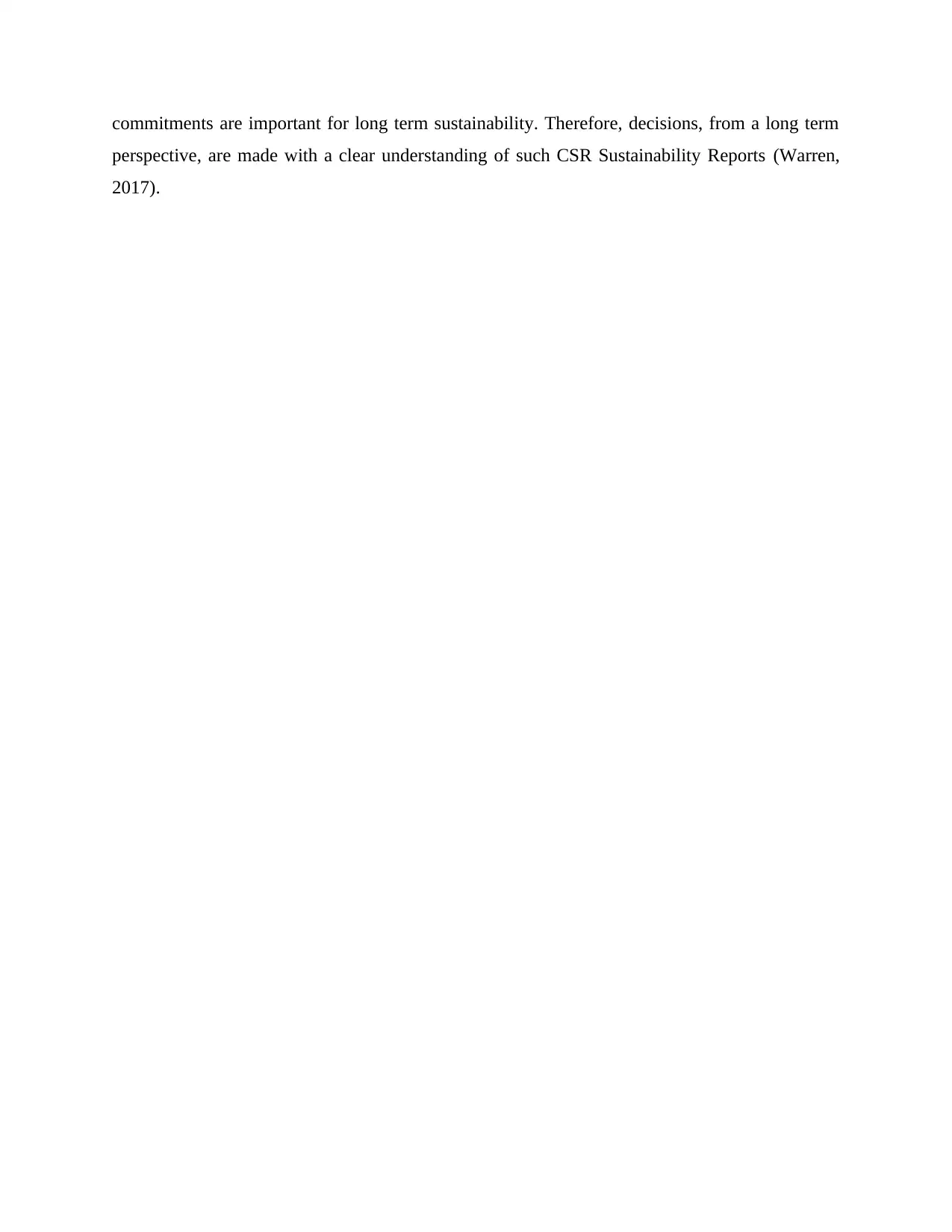
commitments are important for long term sustainability. Therefore, decisions, from a long term
perspective, are made with a clear understanding of such CSR Sustainability Reports (Warren,
2017).
perspective, are made with a clear understanding of such CSR Sustainability Reports (Warren,
2017).

CONCLUSION
It isnot just about assurance, it is about providing smart assurance. For example, the reports are
designedin such a way that it deliversinformationregarding relationship of the company with its
regulators or the cutting of corners at the operation level, if it exists. It is the duty of the company
and such other CSR experts that are suppose to design these reports as the meaningful
communication to its stakeholders. It is the duty of company to provide a commitment to
external reporting and assurance. Also, the experts appointed specially for assessment of such
reports should provide a well informed opinion about whether the company is living upto its
stakeholder's expectations. Without such efforts, these CSR reports would be more of public
relations and less useful for making ethical or investment decisions.
It isnot just about assurance, it is about providing smart assurance. For example, the reports are
designedin such a way that it deliversinformationregarding relationship of the company with its
regulators or the cutting of corners at the operation level, if it exists. It is the duty of the company
and such other CSR experts that are suppose to design these reports as the meaningful
communication to its stakeholders. It is the duty of company to provide a commitment to
external reporting and assurance. Also, the experts appointed specially for assessment of such
reports should provide a well informed opinion about whether the company is living upto its
stakeholder's expectations. Without such efforts, these CSR reports would be more of public
relations and less useful for making ethical or investment decisions.
Paraphrase This Document
Need a fresh take? Get an instant paraphrase of this document with our AI Paraphraser
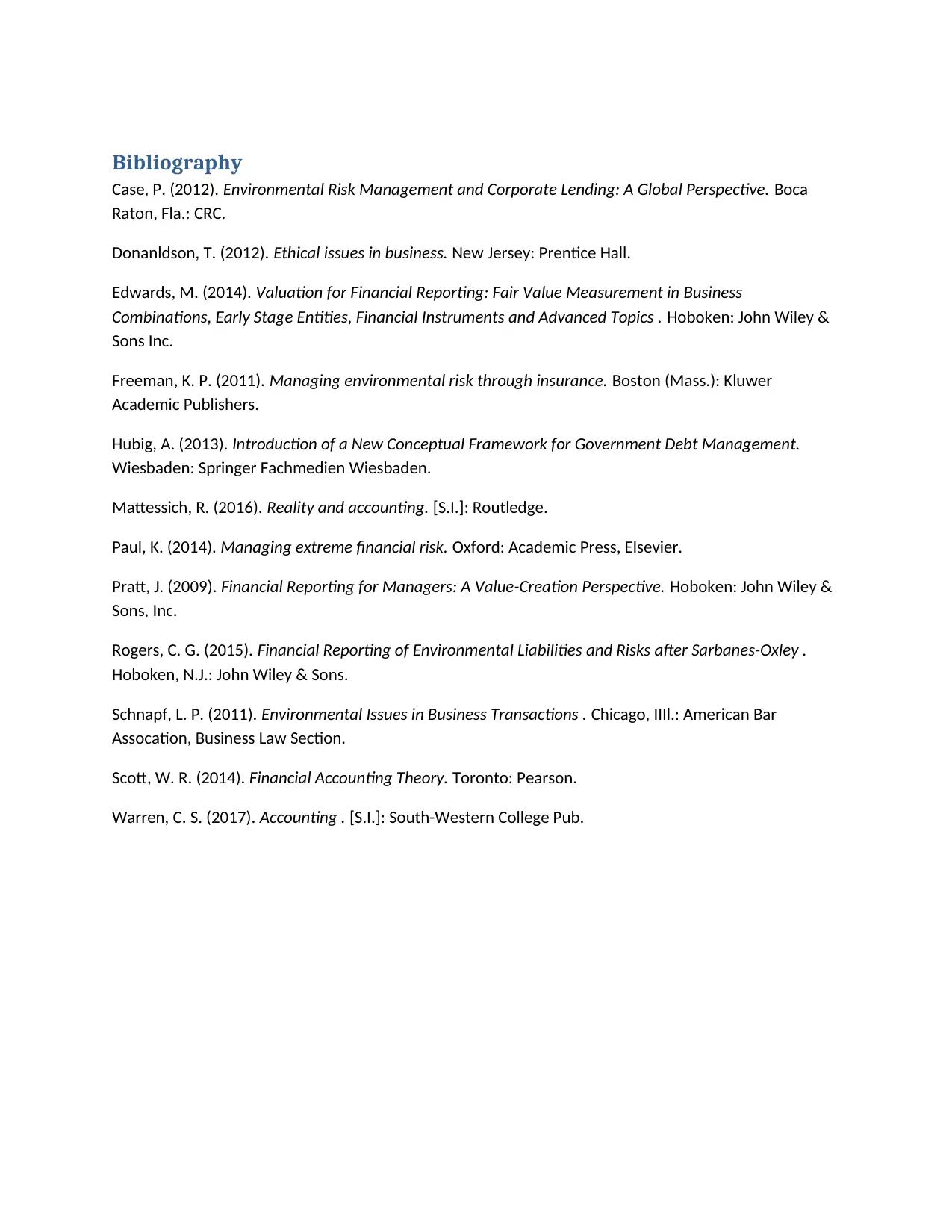
Bibliography
Case, P. (2012). Environmental Risk Management and Corporate Lending: A Global Perspective. Boca
Raton, Fla.: CRC.
Donanldson, T. (2012). Ethical issues in business. New Jersey: Prentice Hall.
Edwards, M. (2014). Valuation for Financial Reporting: Fair Value Measurement in Business
Combinations, Early Stage Entities, Financial Instruments and Advanced Topics . Hoboken: John Wiley &
Sons Inc.
Freeman, K. P. (2011). Managing environmental risk through insurance. Boston (Mass.): Kluwer
Academic Publishers.
Hubig, A. (2013). Introduction of a New Conceptual Framework for Government Debt Management.
Wiesbaden: Springer Fachmedien Wiesbaden.
Mattessich, R. (2016). Reality and accounting. [S.I.]: Routledge.
Paul, K. (2014). Managing extreme financial risk. Oxford: Academic Press, Elsevier.
Pratt, J. (2009). Financial Reporting for Managers: A Value-Creation Perspective. Hoboken: John Wiley &
Sons, Inc.
Rogers, C. G. (2015). Financial Reporting of Environmental Liabilities and Risks after Sarbanes-Oxley .
Hoboken, N.J.: John Wiley & Sons.
Schnapf, L. P. (2011). Environmental Issues in Business Transactions . Chicago, IIIl.: American Bar
Assocation, Business Law Section.
Scott, W. R. (2014). Financial Accounting Theory. Toronto: Pearson.
Warren, C. S. (2017). Accounting . [S.I.]: South-Western College Pub.
Case, P. (2012). Environmental Risk Management and Corporate Lending: A Global Perspective. Boca
Raton, Fla.: CRC.
Donanldson, T. (2012). Ethical issues in business. New Jersey: Prentice Hall.
Edwards, M. (2014). Valuation for Financial Reporting: Fair Value Measurement in Business
Combinations, Early Stage Entities, Financial Instruments and Advanced Topics . Hoboken: John Wiley &
Sons Inc.
Freeman, K. P. (2011). Managing environmental risk through insurance. Boston (Mass.): Kluwer
Academic Publishers.
Hubig, A. (2013). Introduction of a New Conceptual Framework for Government Debt Management.
Wiesbaden: Springer Fachmedien Wiesbaden.
Mattessich, R. (2016). Reality and accounting. [S.I.]: Routledge.
Paul, K. (2014). Managing extreme financial risk. Oxford: Academic Press, Elsevier.
Pratt, J. (2009). Financial Reporting for Managers: A Value-Creation Perspective. Hoboken: John Wiley &
Sons, Inc.
Rogers, C. G. (2015). Financial Reporting of Environmental Liabilities and Risks after Sarbanes-Oxley .
Hoboken, N.J.: John Wiley & Sons.
Schnapf, L. P. (2011). Environmental Issues in Business Transactions . Chicago, IIIl.: American Bar
Assocation, Business Law Section.
Scott, W. R. (2014). Financial Accounting Theory. Toronto: Pearson.
Warren, C. S. (2017). Accounting . [S.I.]: South-Western College Pub.
1 out of 8
Related Documents
Your All-in-One AI-Powered Toolkit for Academic Success.
+13062052269
info@desklib.com
Available 24*7 on WhatsApp / Email
![[object Object]](/_next/static/media/star-bottom.7253800d.svg)
Unlock your academic potential
© 2024 | Zucol Services PVT LTD | All rights reserved.





